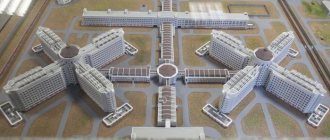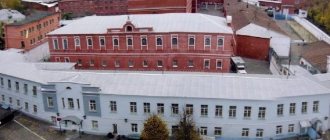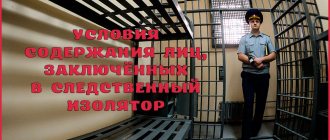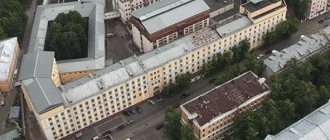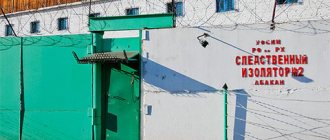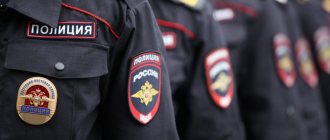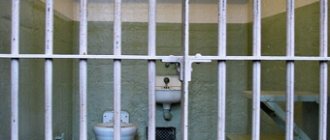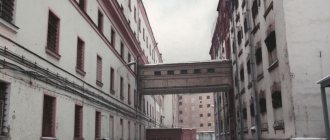St. Petersburg “Crosses” is one of the most famous and largest pre-trial detention centers in Russia. It bears the official name of FKU “SIZO-1” of the Federal Penitentiary Service of Russia for the city of St. Petersburg and the Leningrad region.
Built in 1892, the prison by the beginning of the 21st century had a number of problems related to overcrowding, lack of bedding and general dilapidation of the building. It was impossible to reconstruct the “Crosses” for two reasons: because of the law prohibiting the reconstruction of architectural monuments, which is the building of this institution, and because of the inability to transport prisoners anywhere during the renovation.
In 2006, a decision was made to build a new pre-trial detention center, and on December 22, 2021, all prisoners were taken to the new “Kresty” on the outskirts of Kolpino near St. Petersburg, where the institution remains to this day. This article is dedicated to the old legendary “Crosses”, partly thanks to which St. Petersburg is endowed with gangster fame. Let's consider why the prison is called that, what is the history of the founding of the pre-trial detention center, as well as which of the famous prisoners were imprisoned in this prison and other nuances.
What is it: characteristics of the old MLS in St. Petersburg
“Kresty” is a pre-trial detention center where suspects and accused of crimes are kept. They are not yet convicted, since the court has not yet pronounced a verdict against these persons. The only preventive measure in the form of detention was applied to them. Until the sentence passed by the judge comes into force, the person will remain in isolation and will not be transferred to another institution.
A pre-trial detention center is not a correctional institution; it is not intended to hold prisoners on a permanent basis. Serving a sentence in a pre-trial detention center is only possible if the sentence does not exceed six months.
Where is it located, the address of the pre-trial detention center: 195009, St. Petersburg, Arsenalnaya embankment, 7.
Telephone number of the duty station of this prison: 8 (812) 542-90-14.
The head of the institution is Colonel of the Internal Service Vadim Aleksandrovich Lvov. Reception of citizens on all issues is carried out every second and third Wednesday of the month from 11.00 to 12.00.
You must make an appointment in advance by calling 8 (812) 542-47-35. You can also ask questions to the management of the institution through the online reception https://www.kresty.ru/content/feedback/.
There is a Crosses page on the GUFSIN website – https://78.fsin.su/structure/sizo1.php. In addition, there is an official website of the institution https://www.kresty.ru/, groups on social networks https://vk.com/club2032202, https://vk.com/club1594317, https://vk.com/ kresty_spb.
Those held in a pre-trial detention center have the right to short-term visits (remember that long-term visits in a pre-trial detention center do not exist in principle), applications for which are filled out in the name of the head of the institution. The room's opening hours are from Monday to Saturday from 8.00-16.30 (lunch from 12.00-13.00).
Visiting of museum
Museum of Crosses
Citizens can visit the museum on their own; the limit is for children 14+.
Opening hours: Mon-Fri 9.00 – 17.00, Saturday and Sunday days off.
Ticket price: 50 rubles for citizens of the Russian Federation, otherwise 250 rubles.
Important information! Having a passport when visiting the museum is mandatory!
Photos of St. Petersburg Crosses outside and inside
In the following photo you can see what this MLS looks like:
Institution infrastructure
Why is the prison called “Crosses”? The pre-trial detention center consists of two cruciform five-story buildings , the second building has the same structure as the first. This is where the name of the prison “Kresty” came from. This form was not chosen by chance: at the intersection of two corridors there is a platform from which you can see everything that happens at all four ends and on all floors, with the exception of the fifth, basement. This form is convenient not only because it is visible, but also because it reduces the possibility of prisoners communicating with each other.
The stairwells are covered with metal mesh to protect defendants from accidental injury or intentional suicide. Between the buildings of the detention center there is an administrative building, on the top floor of which is the Church of St. Alexander Nevsky.
The territory also contains four hospital buildings, a laundry, an icehouse , a dormitory for guards, a boiler room with an electric generator, an infectious disease building, a bathhouse and a kitchen with a bakery.
The service personnel at Kresty are the prisoners themselves, who go on duty according to a specific schedule.
Excursion program around the complex
- a walk through the territory of the pre-trial detention center, where you can see a football field and a playground with exercise equipment;
- visiting administrative buildings;
- regime buildings in the shape of a cross;
- demonstration of the prisoners' cell;
- viewing the museum exhibition;
- visit to the Church of Alexander Nevsky.
Guides will introduce visitors to the entire complex of the structure. Supervision and corrections officers will talk about the peculiarities of serving in a pre-trial detention center.
The tour runs daily from 11:00 am. Ticket price is 500 rubles.
Walk “Around the Crosses”
walking tour “Around the Crosses” is of interest . It includes:
- external inspection of the Krestov prison buildings;
- building with the image of a magic square;
- monument to V.I. Lenin at the Finland Station;
- the mystical Liteiny Bridge;
- inspection from the embankment of the KGB - FSB building "Big House".
Held on Sundays, the tour starts at 13.00. Meeting on Lenin Square near the station. Price – from 600 rub. .
Conditions of detention in the St. Petersburg pre-trial detention center
The isolation ward has 960 cells, each measuring 8 sq.m. Initially, during construction, they were planned to be single, but at the moment they contain 2-3 people. In the overcrowded nineties, the number of people in the cell reached 13. The cell contains two-tiered metal narrow bunks, a table, two chairs, and a shelf with personal belongings for each prisoner. Clothing and utensils are allowed “from the outside,” as well as books, personal items, and hygiene items.
The cell has a tap with running water and a toilet . Prisoners are provided with a bathhouse once a week, the duration of water procedures is 15 minutes. Maintaining cleanliness in the cell is the responsibility of the prisoners.
We invite you to watch a video about the conditions of detention in the pre-trial detention center:
Schedule
A prisoner's day begins at 6 a.m. and ends at 10 p.m. The ascent is signaled by the inclusion of bright lights and the radio. After this, it is forbidden to be on the bunk until lights out. Within an hour, prisoners make their beds, wash themselves, and tidy up their cells. Afterwards - breakfast and morning check.
At 9.30 the prisoners go on a walk, which takes place in a small room surrounded by concrete walls. There are bars and barbed wire above this room. Prisoners go out for walks in the same group as they are in their cells . During this time, their cells are subject to sanitization and inspection for storage of prohibited items.
At 12.00 – lunch, at 17.00 – dinner. During the day, prisoners can play board games, read books, write letters, which at the end of the day can be handed over to the prison guards to pass censorship, and engage in their hobbies. After lights out, the radio turns off, but the dim lighting remains.
Meals for prisoners
Prisoners in pre-trial detention centers are entitled to three hot meals a day . Porridge is served for breakfast, soup for lunch, and the second course is porridge again, but with the addition of meat. For dinner there is also porridge, but with fish or vegetables. Prisoners are allowed tea as a drink. For medical reasons, some prisoners are prescribed dietary nutrition, then chicken or beef, eggs and dairy products are added to their diet.
The food in the pre-trial detention center is very meager and monotonous, so food donations are welcome.
Work and study
Since the pre-trial detention center is a place of temporary detention for prisoners , the opportunity to work or study is not provided here. Although initially “Kresty” was a prison where all prisoners worked, in the 50s of the twentieth century it was completely self-sufficient due to the cardboard factory organized on the territory, and during the Great Patriotic War a number of samples of military equipment were developed here.
In 1964, there was a change of regime, and Kresty became an isolation ward, not a prison camp, so prisoners could no longer work here.
Religious issues
The attitude towards religion in “Crosses” is tolerant . Initially, during the construction of the prison, the Church of St. Alexander Nevsky was erected here, which became a club in Soviet times. But since the late 90s, work has been carried out to restore the church; in 2004, the altar and iconostasis were returned. Entrance here is always free for prisoners.
On holidays, services are held in the church; the pre-trial detention center is regularly visited by a priest who confesses and gives communion to the “parishioners.” The Bible and Gospel are freely available in the library, which are in great demand in the detention center.
Representatives of other faiths in the pre-trial detention center are also treated with understanding.
Entertainment and relaxation
In their free time, prisoners are allowed to play board games, which are sent in parcels and packages. The pre-trial detention center has a fairly large library, which is actively used. Employees note that books on religious topics and Russian classics are the most popular among prisoners.
Having free time also inspires prisoners to be creative. The most popular genres here are drawing (including icons), modeling from bread crumbs and crafts from paper and cardboard.
There is a club in “Kresty” where entertainment events are held for various holidays. The prisoners themselves act as decorators, artists and screenwriters here. In the same club, prisoners are sometimes shown various films.
Dates and visits
According to Article 89 of the Penal Code of the Russian Federation, prisoners can be granted no more than two visits per month, lasting up to three hours each. Visits are carried out under the control of guards and if there is an attempt to transfer prohibited items or information to the prisoner that may hinder the investigation or contribute to the commission of another crime, they are interrupted early.
To obtain permission to visit, you must write an application addressed to the head of the pre-trial detention center. In some cases, refusal is possible, most often this can happen due to the illness of the arrested person or in case of violation of the regime (or in an exceptional case when the investigation considers that your visit may interfere with the investigation).
Transfer of products and things
According to Art. 90 of the Penal Code of the Russian Federation, prisoners in pre-trial detention centers are allowed to receive any number of parcels, the weight of which must comply with the rules of mail, as well as transmission, with a total weight of no more than 30 kg per month. For prisoners suffering from serious illnesses (if there is a medical report from the institution’s doctors), there is no weight limit for parcels.
Items, substances and food products that may be dangerous to the life and health of people or used as weapons of crime are prohibited from being handed over to prisoners.
All types of alcoholic beverages , foods that require heat treatment, home-made canned food and perishable foods (dairy products, semi-finished products) are strictly prohibited for transfer.
All products must be factory produced with a stated expiration date.
It should also be remembered that all parcels and transfers undergo thorough inspection , so product packaging must be transparent, otherwise it will be opened. For example, some of the cigarettes will be broken, in case you hid something there.
Opening hours of the delivery bureau: from 8.00 to 17.00 (lunch from 12.00 to 13.00) daily, sanitary day is the last Sunday of each month.
If it is impossible to bring the package, then you can place an order at a local store , and then everything will be delivered directly to the cell, bypassing the inspection procedure, which is especially important for tobacco products. The order desk is open from Tuesday to Saturday from 8-30 to 16-30, lunch from 12-00 to 13-00.
The most relevant products for transfer are those that are a kind of currency in the pre-trial detention center: instant noodles, sugar, salt, and especially tea and cigarettes.
Among the things that are in great demand for donation at “Kresty” are: bed linen, towels, dishes and spoons (made of plastic or wood), underwear, tights, socks, personal hygiene products (soap, razors, toilet paper).
Punishment cell
For violation of the regime or disobedience to the staff of the pre-trial detention center, the prisoner is sent to the Penal Temporary Detention Isolator (SHIZO). In Kresti this is a room not exceeding 4 square meters, located in the basement, with a very small window near the ceiling. The prisoner is there alone, the bunks nailed to the wall are folded up for the daytime, time here has to be spent on your feet or on the damp and cold floor.
In addition, the daily ration in the punishment cell has been reduced. According to Article 118 of the Penal Code of the Russian Federation, the period of stay in a punishment cell should not exceed 15 days.
Museum
Museum of Crosses
1993 was the starting point for the creation of the Crosses Museum. Excursions were conducted only for law students and law enforcement officials. Since 1999, the museum has been accessible to visitors. Museum workers conducted excursions around the administrative and security buildings with a visit to the temple.
Museum exhibitions occupied two small rooms. The exhibits testify to changes, events in the “Crosses”, lifestyle, and the inner world of the inhabitants of the institution. In 2007, excursions were temporarily stopped due to difficulties encountered in the work of the pre-trial detention center staff.
On November 18, 2021, the Kresty museum complex reopened to all visitors. The preservation of an architectural monument and museum exhibition is important for the history and education of young people. So that they remember, know and don’t repeat it...
What is the exposition of the prison museum?
- Documentary evidence related to the historical facts of the life of the country, this institution, and the tragedies of innocently convicted prisoners. Documents on the transformation of the prison for the entire period of its existence.
- The model of the prison demonstrates the architectural design and helps to understand the location of buildings.
- Shackles, types of cell keys.
- Exhibitions of photographs of famous prisoners and political prisoners.
- Information about the activities of the administration in different years.
- Items confiscated from the arrested: chess pieces made from bread crumbs, wooden products, drawings, crafts made from paper and cardboard. Sharpeners, homemade knives, hiding places, binoculars, rolled up notes, and musical instruments are of great interest to tourists.
- Images of tattoos on posters, tattoo machines. Each tattoo has a meaning, symbolizes belonging to a prison caste, and bears responsibility in the criminal world. For example, a tattoo of a ring on a finger with a cross and a crown indicates that the person was a prisoner of the “Crosses.”
- A special group highlights items confiscated from clergy in the 1930s: crosses, icons, etc.
Features of the prison regime
"Kresty" is one of the most famous places of detention in Russia . One of the distinctive features of this place of deprivation of liberty is that since the 90s of the twentieth century, “Crosses” was the most overcrowded prison on the territory of the Russian Federation. At times the number of prisoners reached 12 thousand people.
There were 13 prisoners in 3 bunk cells, and they were forced to take turns sleeping. The air temperature in the cells reached 40 degrees and rarely fell below 30, and the stench, sweat, and smoke were added to this. This contributed to the development of unsanitary conditions and disease, and made prison conditions particularly difficult.
History from the foundation
Construction of the “Crosses” began in 1884 by order of Nicholas II under the leadership of the architect A. Tomishko. The unusual shape of the insulator was his idea. According to the master’s idea, this form should remind prisoners of God, or symbolize the cross placed on their own destiny.
Solitary confinement cells were supposed to resemble a cell and have an environment conducive to repentance, prayer and correction.
Soon after its opening, the prison received its name as we know it. The project turned out to be successful and convenient, so it was later repeated in Samara and Chelyabinsk.
At the beginning of the 20th century, “Crosses” was considered an exemplary prison , made in the European style. The cells contained 1-2 people. The buildings were equipped with the latest technology of the time. They had flush toilets, ventilation, and central heating.
Before the revolution, the pre-trial detention center became almost entirely an institution for holding political criminals, although before that it had predominantly a criminal element. The era of Stalin brought a new popular article - “Enemy of the People.”
During the Great Patriotic War, most of the convicts and prison staff died.
Almost every day the territory of “Crosses” was bombed. The hunger and cold of the blockade claimed many lives. After the end of the war, the destroyed buildings began to be restored; in the 60s, old ones were restored and new blocks and production facilities were built.
The most difficult years in the fate of “Kresty” were the 90s , when the isolation ward was overcrowded. During this period, tension among prisoners was particularly strong, resulting in constant clashes between prisoners. Such clashes often led to murders.
By the end of the 90s, conditions in the pre-trial detention center improved. In “Kresty” the bunks were changed and the bathrooms were improved. In 2004, the Church of St. Alexander Nevsky was restored, the altar and dome crosses were returned to it. Unfortunately, due to the design features of the buildings, they are not subject to major repairs. Any redevelopment will lead to the destruction of the building.
We invite you to watch a video about the history of the pre-trial detention center:
The most famous prisoners
Over the years of its existence, many famous people have visited the walls of “Crosses” . Before the revolution, the Bolsheviks A.V. Lunacharsky, V.A. managed to visit “Kresty”. Antonov-Ovseenko, L.D. Trotsky. The latter even took his pseudonym after the name of one of the local guards.
In the 1930s, victims of Stalinist repressions convicted under Article 58 served their sentences here: historian L. Gumilyov, Marshal K. Rokossovsky, actor G. Zhzhenov. Later, the list of “star” prisoners was supplemented by the writer D. Kharms and the poet I. Brodsky.
Escapes
Over the entire history of the “Crosses,” several escapes have been made from them . The first and only successful escape was made in 1922 by the robber Lenka Panteleev. With the assistance of one of the guards, he managed to break free.
The most prominent “fugitive” was the bandit Sergei Maduev, nicknamed “Chervonets,” in 1991. He managed to charm a female investigator, entered into a relationship with her, and his lover brought a pistol to his cell. Maduev took a hostage, wounded a major from the guard, but he himself was shot, and the release plan failed.
Having recovered from his injury, Chervonets still did not give up his idea and managed to convince one of the guards to give him his service weapon. He later justified himself by saying that he was under Maduev’s hypnosis. But this time the guards were very vigilant, and the escape was unsuccessful.
In 1992, according to the Maduev scenario, seven people already tried to escape from “Crosses” . Having taken two prison staff hostage, they demanded freedom. The special forces operation ended with the release of the hostages and the death of the three main initiators of the escape.
There were also comical cases of escape attempts, when prisoners forged prison employee IDs, dismantled the brickwork of the walls, etc., but all of them were unsuccessful.
Due to the fact that the death penalty is prohibited in Russia, the most terrible and dangerous criminals are placed in special regime colonies. On our online portal you will find information about such terrible Russian prisons as the White Swan, Black Dolphin, Snowflake, Polar Owl, Vologda Pyatak, Matrosskaya Tishina, Black Golden Eagle, Vladimir Central, Butyrskaya.
Mysticism and horrors of St. Petersburg “Crosses”: what the legendary prison hides
“Those who find themselves in the “Crosses” have two ways: to cleanse their soul through the Orthodox cross or to put an end to their future destiny.” These are the words of the architect Antoni Tomisko, who built the legendary prison. His ghost is still met and even recorded on video by guards in the corridors of the ancient pre-trial detention center...
This year, the St. Petersburg detention center was remembered twice: when President Vladimir Putin told how prisoners here had their teeth removed without anesthesia, and when it became known about the closure of the pre-trial detention center. If everything is not so clear with the teeth, then the rumors about closure are true.
Having visited “Crosses”, we learned:
— What the dungeons of the largest prison in Europe still hide;
— Where did the extra camera come from in “Kresty” and where did it go;
Why Marshal Konstantin Rokossovsky did not want to leave prison;
How Chervonets’ romance with investigator Vorontsova actually developed.
Golden key of the “citizen boss”
FROM THE MK DOSSIER : “The prison appeared in 1868 on the site of a wine town, where the wine of all St. Petersburg was stored in barrels. About 20 years later, the premises were rebuilt according to the design of the architect Tomisko.
The name “Crosses” is explained by the fact that the prison consists of two buildings, each of which has the shape of a cross. It was built by the prisoners: they themselves, brick by brick, built their new prison house.”
The deputy takes me to Kresty. Head of the Federal Penitentiary Service for St. Petersburg and the Leningrad Region Alexey Chergin. He is her former boss (he admits that he is still drawn here).
Corridors of “Crosses” today Photo: Eva Merkacheva
Just as a theater begins with a hanger, so a prison begins with a checkpoint and a transfer office. You won’t see a queue here now, but once it was almost a kilometer long, and Anna Akhmatova stood in it for hours (her son Lev Gumilyov was sitting in “Kresty”). In the famous poem “Requiem” she left a will: “And if someday in this country they plan to erect a monument to me... then here, where I stood for three hundred hours and where the bolt was not opened for me.” The monument, by the way, was erected relatively recently - in 2006. The bronze Akhmatova stands on the embankment and sadly looks towards the “Crosses” (and her plaster version is located inside the pre-trial detention center).
The brick walls of the oldest operating prison in the Northern capital are strong, as if they were built yesterday (this is because chicken eggs were added to the mortar). No one was able to ram them, but they were able to disassemble them. This happened in 1946. Then a prisoner named Volkov carefully took a brick out of the wall every day and put it in a bucket (it was emptied daily).
At one point, the guards saw a hole in the wall of the cell. The prisoner is missing. Once free, Volkov first went to the bathhouse, where, ironically, the guards were steaming at that moment. They recognized him, gave him a wash and brought him back to Kresty, clean and with white hands...
So, checkpoint. Visitors' passports and all documents are taken away and they are given tokens instead: this has been a mandatory requirement for entry since 1984.
“Then the most intellectual escape from Kresty took place,” says Chergin. — Two prisoners used cardboard and red thread to make fake IDs for senior investigators of the Central Internal Affairs Directorate. For photographs, they used printed images of employees cut out from magazines. The seals were taken from copies of the verdict.
This was the time when the number of prisoners was off the charts, so control was weakened. And so they went to see the doctor and changed into white coats made from white sheets. Wearing dressing gowns, we reached the checkpoint, where we threw them off and, showing our homemade IDs through the glass, found ourselves free. Naturally, we considered the version of bribery, but it was not confirmed. Two days later the fugitives were found, but this whole story became a lesson for the jailers.
“People have their heroes, prisons have their bosses” - for some reason this saying has taken root in “Crosses”. The current head of Kresty, Vadim Lvov, is a modest but cheerful man (and for the sorrowful prison business, as Peter the Great said, this is exactly what is needed) - shows a gallery of portraits of his predecessors.
Few of them died of natural causes.
The first chief (who is also vice-governor) Ivanov, for example, was shot dead by revolutionaries. Vladimir Smirnov lasted the longest in his post and left it alive, but very sad.
“In 1991, he was invited to America to exchange experiences,” old-timers say. “The head of the local prison met him, showed him his ranch, a herd of horses, and took him for a ride in his own helicopter. Vladimir Mikhailovich guessed that in the States everything was decent, but not to that extent. In general, he returned and immediately quit. No matter how much they tried to persuade him to stay, it was useless!
After Smirnov came Stepan Demchuk.
“He had the most difficult times, when there were 12 thousand prisoners in the prison,” says Chergin. — Think about it: 12 thousand is almost a city! I still don't know how we all coped back then. There is no electricity, no food (we owed it to all the bakeries in St. Petersburg), no clothes.
I remember how Demchuk - short, thin, with big ears - smoked and cursed all the time, sitting in a huge chair. But what a sixth sense he had! Both staff and prisoners will tell you about this later.
All the bosses of Krestov occupied the same office on the first floor. There in the very corner there is a secret, barely noticeable door. Behind it is an old safe. Lvov, who has been leading Kresty for the last three years, squints his eyes slyly:
“Only the heads of Krestov, no one else, could know the secret of the lock of this safe, made in 1892. There are four of them alive today. And only I have the key. Here he is. There is only one way to open the door - to become the boss.
The head of Krestov shows a secret safe from 1892 Photo: Eva Merkacheva
But to open the door of the ancient temple in “Kresty”, you don’t need to know the secret code and have a “golden key” with number 1. This temple was built with money from ordinary St. Petersburg residents and was once open to everyone. Then the communists made offices there, painted over the frescoes, and removed the icons. Only in 2002, the beautiful room with a huge dome was consecrated again. Recently, under seven layers of plaster, frescoes and icons of simply fantastic beauty were discovered. Their fate has not yet been decided.
“MK” REFERENCE : “During the war, one regime corps operated. At that time, the prisoners were guarded by old men, women and disabled people (400 employees went to the front as volunteers immediately after the start of the war). During the blockade, food standards for prisoners were the same as for city residents. Both prisoners and employees died of hunger. The corpses were stored in the morgue, which was set up in one of the premises.”
Once upon a time, the corpses of deceased prisoners were placed here Photo: Eva Merkacheva
“18 people for three shkonars”
Building No. 1 for 480 cameras. I am in the center of the large cross and, turning my head, I can see what is happening in each of the four ray-corridors. Grandiose!
“By building a prison of this shape, the architect gave the opportunity for the sun, as it rotates, to look into almost every cell,” says senior inspector Natalya Klyuchareva. — Which in the case of the St. Petersburg climate, with its rainy weather, plays absolutely no small role. The entire prison is built on the principle of a panopticon - maximum illumination and openness for observation of prisoners. In general, in Russia, prisons with domes were not built before the “Crosses” (they were built on the principle of dungeons).
It is thanks to the dome, through which the light flows, that it is possible to conduct observation through all four floors. All floors between floors were visible. The ceilings are vaulted, reminiscent of arches. So, if at least one load-bearing wall in a building is demolished, then all the others will collapse. It is impossible to convert.
This is the door through which prisoners are taken for walks, but here are the mailboxes for prisoners’ complaints...
Convict of the household service detachment is ready for relocation from the old “Crosses” to the new ones Photo: Eva Merkacheva
I go into the cell. It is very small - 8 square meters. meters. Initially it was assumed that the royal prison would be solitary, that is, one person per cell. Nowadays there are mostly three people sitting here.
- Yes, this is a sanatorium compared to what happened here before! - says one of the prisoners. — I was here in the 90s, when there were 18 people in the cell. For three shkonars!
“It was like that,” confirms Chergin. “A normal person there should have been horrified.” But we all took it for granted at that moment. The prisoners did not open the cell doors when the next one was brought to them. It was barely possible to squeeze him in there. Things were already handed over to people's heads. I still remember - and it’s already scary: how did they survive then?
“At that time, we somehow calculated that about 1,200 prisoners had already been in prison for 1.5–2 years for nothing at all,” says the former deputy head of Krestov. - Who stole the feed, who stole the sheep... We decided to invite all representatives of the city and regional courts here. I tell them: let's free these ones; Well, why are we tormenting ourselves, torturing them... And the judges respond to this: “As we arrested, so will we be.”
By the way, representatives of Themis were also our “clients”. One judge came to us, his last name was Kazakov. He was suspected of the brutal murder of his wife (I personally knew her - she was a good woman). They didn’t prove his guilt - he was released three years later. And soon he got into an accident and died. He was very bad and harmful in himself. They even tried to blow up Kazakov once in court: they brought a grenade into the courtroom. Then the bailiff suffered... During this period, by the way, the number of prisoners in our country already exceeded 16,000.
This is what the camera looks like in the old “Crosses” today Photo: Eva Merkacheva
And now recidivist prisoners don’t complain about anything at all, because they remember the past. They have the least problems. They say: “We never dreamed that there is now! We wouldn’t have believed then that years would pass and it would be like it is now.”
- Well, what about tooth extraction without anesthesia? Isn't this the last century?
- I’ll tell you how it all happened. Before Putin’s arrival, they told him to voice the most important problem. And at that moment it was medicines (there was a catastrophic shortage of them). Well, one of our employees, Alexander Zhitinev, told the president that there were no painkillers. And this later resulted in a scandal...
I go into cell No. 371. It was there that President Vladimir Putin visited. Clean, modest and again cramped. Two prisoners are seated near the table, drinking tea.
The cell in which Putin was Photo: Eva Merkacheva
In general, all cameras are completely identical. Old-timers say that everything that is here has not changed almost since 1918. True, the wooden bunks were replaced with metal ones, and the third tier was “cut off”. A couple of years ago, shower rooms were installed on the second and third floors, and now at Kresty there are no strict regulations regarding access to the shower (it used to be the same: only 15 minutes, and not a minute more, for the entire wash).
FROM THE MK DOSSIER : “At the beginning of the 19th century, in the Krestov cell, the bed was attached to the wall immediately after being raised and lowered only during bedtime. During the day the prisoner could not use it. But he had a chair, a table, and a shelf at his disposal. The dishes on the shelf had to be kept strictly in a certain order: copper bowl, plate, teapot, salt shaker. Otherwise he was punished. They could also punish him for not cleaning the dishes with sand or bricks.”
This is what the camera looked like at the beginning of the 2000s Photo: Eva Merkacheva
But old walls are not always ready for innovations - ventilation here is almost impossible, and at night the temperature in “Kresty” does not drop below 30 degrees. During this period, the head of the prison signs an order: on even days, the windows of the cells are opened on one side, on odd numbers, on the other (to create air movement).
- Call the librarian! Need books! - the prisoner shouts from the cell.
“The most popular work of art was and remains the novel by Fyodor Dostoevsky,” the employees tell me in a whisper. “It is truly existence that determines consciousness.”
The two prisoners are silent - chewing bread. It turned out that they have been doing this continuously for two days now. Then they will lay it out on a cloth so that the oxygen can escape. And then others will sculpt figures from this mass.
“We have a division of labor: some chew, others mold,” explain those whose mouths are “not busy.” “Then we’ll decorate the figures with paste from colored pens, and they can be stored for three years.” This year it was a wet summer, so many of our figurines, tormented by bread bugs, died.
Everyone who “checked in” to “Kresty” received such instructions. Photo: Eva Merkacheva
Meanwhile, a dove knocked on the window. Employees say he may have arrived with a message.
“Previously, prisoners used a homemade blowgun (made from newspapers) for communication,” says inspector Natalya Klyuchareva. — A note weighted with a bread ball is placed on one end, and on the other side is a person with strong, healthy lungs. In calm weather, such messages fly a distance of 40–50 meters and land on the embankment. There were days when she was covered in writing. For a fee, grannies delivered letters to specified addresses (if no one was waiting for a letter on the embankment). But today carrier pigeons are in fashion.
“And we have Tarzan sitting here,” the prisoners shout from one cell.
Mixed martial arts fighter Vyacheslav Datsik, nicknamed Tarzan, is, as they say, quiet and bright. “Crosses” is already witnessing his second coming, so the staff selected cellmates suitable for his character.
Along the way, the operatives do not brag, but proudly tell how they solved the murder of children (there was a maniac in “Kresty”, and here he confessed to crimes that no one knew about) and returned the stolen paintings to one of the museums (“split” kidnapper).
Ghost Chamber #1000
There have always been and still are only 999 cameras in Kresty. But they say that the architect of the prison, Antoni Tomishko, was placed in cell No. 1000.
It was supposedly like this. The architect, reporting to Emperor Alexander III, was obviously worried, so he said: “Your Majesty, I built a prison for you.” “Not for me, but for himself,” the king abruptly interrupted him and imprisoned him in the “Crosses.”
Photo: Eva Merkacheva
“They still can’t find cell No. 1000 where he was put,” says Klyucharyova. - This is not a joke, we've covered everything here. If you find it, you will go down in history.
There is a lot of mystical stuff associated with Tomishko. We were unable to find out where he was buried. There is a version that it is at the Nikolskoye cemetery, but his grave was not found there... Many employees say that they heard or saw the ghost of the architect. In 2008, surveillance cameras recorded how a certain white creature emerged from the roof, rose up, then sharply down, up again and disappeared into nowhere.
The writer Daniil Kharms died in the winter in the most difficult conditions within the walls of “Kresty”... In general, a separate book could be written about the famous prisoners who passed through “Kresty”.
They let me leaf through the old yellow pages of a register of prisoners admitted and released. I am looking for names familiar from history and literature textbooks.
Alexander Kerensky . The future head of the Provisional Government came here in 1905. By the way, his notes have been preserved: “I remember with gratitude the absurd incident that brought me here. Four months of seclusion at state expense.” He wrote that the regime in Kresty is very liberal, that the doors in the cells practically do not close, the prisoners communicate with each other, play chess. “And it was a time of rest and reflection.”
Vladimir Nabokov (father of the author of Lolita, leader of the Cadet Party). In 1906, the last Russian Emperor Nicholas II dispersed the Duma deputies and then sentenced them to three months in prison. The deputies turned out to be law-abiding, they independently - with their belongings, in cabs - arrived at the main entrance of the prison. Among them was Nabokov, who took his favorite literature and a rubber bathtub with him to Kresty to wash himself. The staff show me photos that depict the process of “checking in” the prisoners (it’s amazing that all this has been preserved!).
Leon Trotsky . The revolutionary visited Kresty twice. For the first time here, he wrote, read, debated with his comrades and was angry with the employees for taking him away from work and taking him for a walk.
The second time Trotsky was here - but not as a prisoner - was in 1917 and wrote an angry article called “Shame” about how human rights were not respected in the main Russian prison. The number of prisoners in the cells was already off the charts (this was the time after the February Revolution). Oh, if only he knew how human rights were not respected later in the Soviet Union, in the construction of which he took a direct part. It is interesting that Lev Bronstein took his pseudonym - Trotsky - from the surname of the warden of the prison in which he was imprisoned (but not in St. Petersburg, but in Odessa).
I scroll further. Chemist Fyodor Liberovsky, famous orientalist, author of a poetic translation of the Koran Theodor Shumovsky, poets Oleg Grigoriev, Nikolai Zabolotsky, Joseph Brodsky...
Georgy Zhzhenov . I can't help but dwell on this prisoner.
— When he got into the overcrowded cell, he was 18th in a row; and he got a squatting place near the bucket,” says Natalya. - Come on, I’ll show you where it is...
Fourth floor of the first building. The camera, almost on the corner, is no different from the others. But Zhzhenov changed several cameras, shortly before his death he visited “Kresty”, tried to remember them, but could not...
However, another eminent prisoner, the future Marshal of the Soviet Union Konstantin Rokossovsky, also changed many cells. He spent 30 months in Kresty on false charges, from 1938 to 1940. Few managed to endure what Rokossovsky experienced: he lost 7 teeth, 3 broken ribs, and his toes were completely broken with a hammer (all his life after that he was forced to wear orthopedic shoes). He was taken three times to be shot in the basements of Krestov!
“But he didn’t incriminate anyone,” continues Natalya, who has been collecting the memories of old-timer guards bit by bit over the past years. “His release took place on a rainy October evening.
The sick, exhausted Rokossovsky looked - where now, alone, at night, without any means? And he asked the duty officer for permission to stay overnight until the morning. And the newly arrived shift discovered some shortcomings in Rokossovsky’s personal file, and the proceedings dragged on until the evening. It began to rain again, but Rokossovsky did not tempt fate a second time.
When the Paulus group was captured near Stalingrad, congratulatory telegrams were sent to Rokossovsky from all over the country. Among them is one from the head of Krestov.
By the way, Stalin did not apologize to anyone, but he apologized to Rokossovsky twice: “We offended you, Comrade Marshal. They offended me deeply." Rokossovsky himself in his memoirs did not say a word about these 30 months of his life. But until the end of his days, he did not part with the small black Browning, he said: “They will come again - I won’t give up alive.”
Andrey Tupolev . The aircraft designer was brought here under Article 58, which means that a person is “not loyal to the regime.” I was not sitting in an ordinary cell, but in a separate building, where from 1939 to 1941 there was a sharashka (a special design bureau, a prison for scientists who worked on projects of national importance).
Andrei Tupolev and Georgy Zhzhenov donated their prizes to “Crosses”, and with this money they installed water supply and sewerage here.
Blood and death of the 9th Corps
“Don’t go there, this building is frozen,” the staff discourages me from researching. “No one has been there for exactly six years.” There... there's a tuberculosis bacillus!
Basement cells of the ninth building Photo: Eva Merkacheva
The ninth building is the darkest place in “Crosses”. Initially it was built as a dormitory for employees of the St. Petersburg solitary prison. It is noteworthy that during their free time from duty, they could leave the hostel territory only with the personal permission of the head of “Crosses”. So the employees were as much prisoners of this prison castle as the criminals. Women have been held here since 1988. And then it was given to patients with open tuberculosis.
Reluctantly, the guards open the locks. We're inside. Everything here is destroyed, there are fragments of furniture and some objects lying around. We go down to the basements where there were investigative rooms. And then one of the old-timers talks about the most terrible day of the ninth building of “Crosses” - when it was captured by prisoners:
- There were seven of them. All of them had serious charges and serious sentences, and two were even threatened with execution. The plan was this: to attack an employee, take possession of the keys to the exercise yard and from there get to the tower (the structure of the building is such that the tower is crowned with a roof that is closely adjacent to the civilian building).
The psychological calculation was based on the fact that everything would happen on February 23. In general, they attacked and took the keys. But the guard managed to sound the alarm. These seven went berserk and returned here, where you are now, smashing and destroying everything in their path.
In one of the offices there was cognac, confiscated from the lawyers by operatives. The prisoners naturally drink it. The already seething adrenaline does its job - they take two hostages: a sub-inspector (woman) and a dog handler. This is exactly what happened here.
I imagine how on February 23, 1992, distraught prisoners called from this preserved telephone and demanded money, weapons, transport to the airport and a plane to Sweden.
Here in 1992 a hostage crisis took place Photo: Eva Merkacheva
— Negotiations were conducted personally by Demchuk. They invited relatives of the prisoners to persuade them. They even asked one well-known crime boss (he was being held in Kresty at that moment) to enter into negotiations. By the way, he agreed immediately. But it was all to no avail.
Come on, I’ll show you where the assault began. Do you see this grill on the window? On the third attempt I only managed to pull it out. Then they smashed the door for a long time, and when it gave way, the dog handler instructor Alexander was already stabbed to death (7 stab wounds).
Inspector Valentina was not injured: a sniper on the roof guarded the approaches to her. But she was treated for a long time and died two years later: her heart could not stand it. By the way, Alexander has three children left, so one of them is now in the St. Petersburg pre-trial detention center, the second is in Moscow in the department of internal security. The widow heads the criminal-executive inspection in one of the districts of St. Petersburg.
She recently told how one of the surviving prisoners (three died during the assault, the rest received sentences) called her. And he even seemed to try to ask for forgiveness. And he ended up asking for money...
Lyubov Chervonets
The Soviet years were the most significant for Kresty. By the way, at that time the mother of the current head of the Investigative Committee, Alexander Bastrykin, worked here.
“She was a warrant officer, a very responsible woman,” the employees recall.
Kostya Mogila, Tambov, Malyshev, Kirpich... - how many famous authorities passed through “Crosses” then.
“I, as deputy chief, communicated with them a lot,” says Evgeniy Bozhadze. - They are all serious people. They are developed, erudite. They sit all their lives and read all their lives. Their convictions are strong.
They knew that there was no need to ask me for anything, that it was useless. And that’s how they offered everything: dachas, houses, cars. And how many were invited to restaurants! You had to be able to refuse harshly. And don’t let them get too familiar at all. Chervonets (in 1991, the famous bandit Sergei Maduev, nicknamed Chervonets, was kept in “Kresty” - author’s note) was weaned from his habits. Clean, ambitious, he did everything on show off.
There was a case when he was not allowed into the restaurant (there were no seats), so he took a pistol and shot the guard. When he was free, he wore a white suit, white shoes and a shirt... And behind bars he tried to show that he was special.
After all, when he was in Butyrka, he attacked the boss. Strong as a bull, he did push-ups on his fingers! But when we fought back, it turned out that he was terrified of pain, like a child!
Before Bozhadze’s eyes, Chervonets’ romance developed with Natalya Vorontsova, an investigator for particularly important cases at the Prosecutor General’s Office (it later formed the basis of the famous film “Prison Romance” with Alexander Abdulov in the title role).
“I’ll tell you how it really happened,” says Bozhadze. “Chervonets, the son of a bitch, made sure that Vorontsova was his investigator.” Sometimes they would take him out for interrogation, but he would remain silent. And then: “I’ll tell her everything.”
He knew Vorontsova before and even, as a good friend, handed over several “cache” to her. He talked her into bringing him a gun. Chervonets really had almost mastered hypnosis (by nature he was predisposed to this - the son of a Chechen and a Korean woman, his mother sat endlessly, he was forced to get a piece of bread from childhood). Several times my subordinates told me:
“There’s a scandal, Vorontsova is crying, hysterical.” And then she: “Oh, don’t touch him, don’t punish him, it’s all my fault.” And, apparently, he was already influencing her psychologically. She was worried about him - “he’s so poor.” I say: “Why is he poor? Look at his cheeks. He eats what he wants, they give him better food than in a restaurant.”
And so she brought him a revolver to “Kresty” (and the prosecutor’s office employees are not searched). After this, Chervonets asked for three days to the boss Demchuk: “Let him accept it! I’ll tell you where the rest of the loot is buried.” But as Demchuk felt, he didn’t accept it. And at that moment Demchuk gave the order to place one machine gun at the post where the southern gate is, because the criminal cannot be stopped with a Makarov pistol. And if it weren’t for this machine gun... Chervonets would have left with a revolver during the escape attempt. And so, when he saw them running at him with a machine gun, he fell to his knees and surrendered.
Natalya Vorontsova received 7 years in prison. They say that he now lives in Crimea and is supposedly not in poverty. And Chervonets was sentenced to death, which was later commuted to life. In 2000, suffering from diabetes, he died in the Black Dolphin colony.
Bozhadze, accompanying me along the old corridors of “Crosses,” points first to one cell and then to another, remembering the famous inmates.
— This is the camera of the director of Suntrest, the largest plant in St. Petersburg. He and his deputy made illegal batches of cognac, for which they were imprisoned. And here is the director of Lenbythim. He was sitting with the head of a meat-packing plant, who received a prison term for his doctor's sausage. I asked him about this sausage then. He honestly told how they made it: a ton of meat, a ton of grain, a ton of starch and a ton of toilet paper or napkins. That's what he told me! Why would he lie? So these are not all stories. It was hard for them to sit - already under socialism they felt like an elite and lived beautifully.
New life for an old prison
“Crosses”, “Crosses”... The very thought that the legendary prison will not exist frightens many. This is the history of an entire city, an entire country, an entire era.
“No one will touch the “Crosses”, what are you worried about,” reassures the head of the Federal Penitentiary Service of Russia for St. Petersburg and the Leningrad Region, Major General of the Internal Service Igor Potapenko. - This is a historical monument. It’s just that all the prisoners will be taken out of here in the coming days. The building will be used as a museum, as a film set (the cameras will be preserved in their original form). Part of the premises will be occupied by the office of the Federal Penitentiary Service, there will be a reception of citizens and much more.
The construction manager shows the model of the new “Crosses”, which will open one of these days Photo: Eva Merkacheva
And the prisoners will move to a new pre-trial detention center.
“Crosses-2” was built on the outskirts of St. Petersburg, and this, according to experts, is the most grandiose prison in all of modern Europe.
Construction is almost finished. I am led along the new “Crosses” (they are also in the shape of a cross, with galleries built so that you can get into any building from any corner of the building). 164 thousand square meters, each cell resembles a dorm room. For the first time in the history of the Russian prison system, 7 square meters were allocated for each prisoner. meters.
New "Crosses". Built on the same principle as the old ones Photo: Eva Merkacheva
There are so many investigative offices that lawyers may not leave here for even days - there will still be no queues. Inmates from almost all detention centers in St. Petersburg will be transferred to the new pre-trial detention center, designed for 4 thousand places. A heated football field, a fenced area in case of mass unrest... There will be several security lines here, and digging is simply impossible: the fence goes three meters underground. Grandiose, powerful, but even somehow scary... This is a whole separate city of prisoners - how will it live?
I look around at Kresty-2: there aren’t even bars on the windows, the pre-trial detention center looks like a residential complex. And I hear the voices of passers-by: “What do you think, how much does an apartment in this residential complex cost?” - “So this is a prison!”
This is what the camera looks like in the new “Crosses” Photo: Eva Merkacheva
Once upon a time, everyone who completed the “Crosses” could get a tattoo in the shape of a ring, in the center of which was a cross with a crown. Such a tattoo guaranteed a great criminal future. What tattoo will those who find themselves in “Kresty-2” “draw”? Time will show…
Eva MERKACHEVA, Moscow—St. Petersburg
Mentions in popular culture
The songs of M. Krug, A. Rosenbaum, G. Pick, V. Nochny are dedicated to “Crosses”, some of them are dedicated to personal experience of being in a pre-trial detention center. Also, references to them are found in the poems of I. Brodsky, V. Zeest, A. Akhmatova, M. Shcherbakov.
The detention center appears in the fourth season of the television series “Cop Wars.” According to the plot, the hero of Alexander Ustyugov is serving a prison sentence in “Kresty”.
This same institution is given special attention in the documentary film by V. Mikeladze “The Last Bandit of the Soviet Union” from the series “Sentenced for Life.” In another documentary series, in “Criminal Russia”, the two-part issue “Escape from the Crosses” is dedicated to the detention center .
The era of the old “Crosses” as a prison is over. The fate of the historical building on the Arsenalnaya embankment in St. Petersburg was not decided for a long time. By the end of 2021, it was decided to turn it into a museum of the Kresty prison, which will be dedicated to the history of the institution, its prisoners and their creativity. Entry will be free for everyone.
How to get there?
Museum address: St. Petersburg, Arsenalnaya embankment, 7.
Nearest Metro station: Lenin Square - 650 m.
Transport routes passing near the pre-trial detention center-1 Kresty:
- Buses: No. 133, 46, 49, 86.
- Minibuses: No. 107, 367.
Nearest stops:
Mikhailova Street – 310 m,
Children's Regional Hospital – 450 m,
Finland Station – 650 m.
Popular operators in St. Petersburg:
Taxi: Uber, Taxovichkof, Gettaxi, Yandex.Taxi. To choose a taxi with a cheap tariff, you can use the dispatch service “Taxi Cheap St. Petersburg”
Car sharing: Yandex Drive, You Drive, Delimobil, CarSmile.
Parking for personal and rental cars is located in the “Car Parks and Garages” area.
